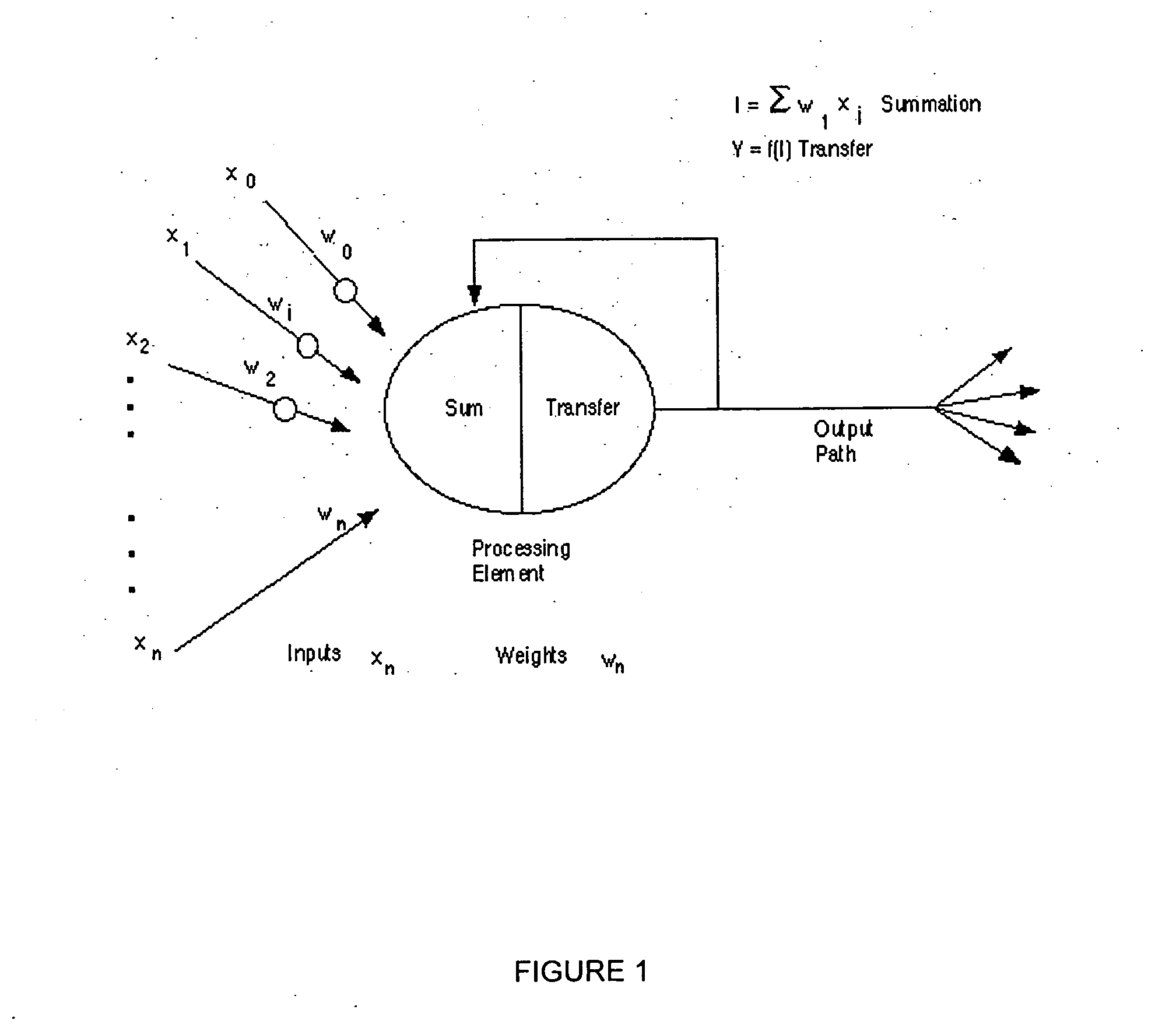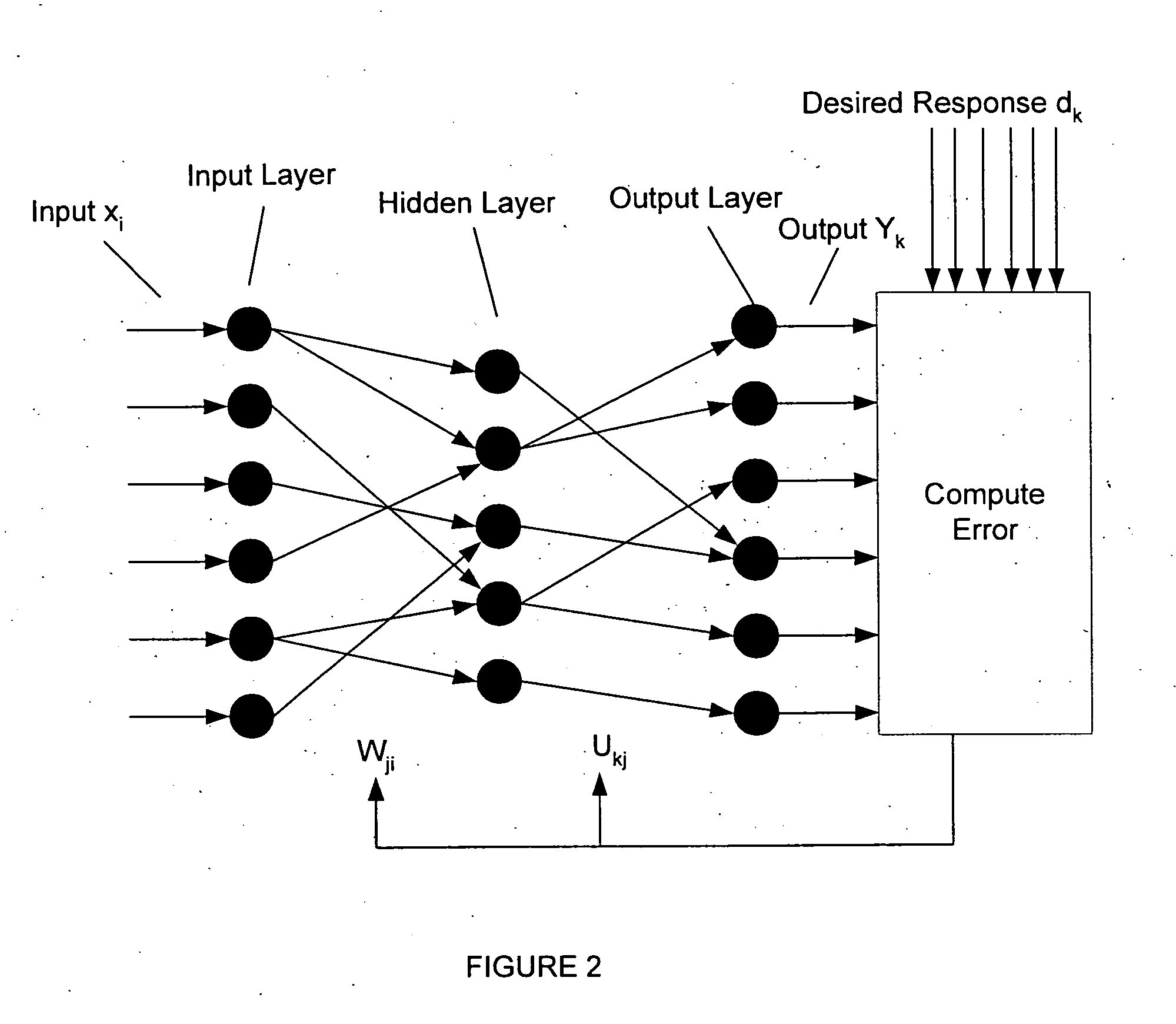Neural network pattern recognition for predicting pharmacodynamics using patient characteristics
a neural network and patient technology, applied in the field of neural network pattern recognition for predicting pharmacodynamics using patient characteristics, can solve the problems of toxic serum concentrations, and inability to accurately predict drug plasma concentrations
- Summary
- Abstract
- Description
- Claims
- Application Information
AI Technical Summary
Benefits of technology
Problems solved by technology
Method used
Image
Examples
embodiments
[0086]FIG. 3 illustrates one embodiment of the invention, wherein the neural network effect predictor (NNEP) 300 comprises a neural network (NN) 310, a database 320, a validating unit 330, a central processing unit (CPU) 340, and input unit 350, and a display 360. NN 310 is preferably an artificial neural network implemented in a computer programming language such as C++ or Matlab®, and is executed by CPU 340. Alternatively, the NN 310 is implemented in a hardware device such as a semiconductor chip. Database 320 comprises training data 323 for training the NN 310 and validating data 325 for validating the pharmacodynamic predictions of the NN 310 in the validating unit 330. Validating unit 330 is preferably implemented as a software component and compares the validating data 325 to the output of the NN 310 to determine the error in the NN 310. CPU 340 executes the NN 310 and the validating unit 330, and reads and writes to database 320. Input unit 350 allows training data and valid...
example 1
Predicting Pharmacodynamic Behavior of Abciximab
[0109] Abciximab is an antagonist of the platelet GPIIb / IIIa receptor and is effective in preventing coronary thrombosis following percutaneous transluminal coronary angioplasty (PTCA). Clinical dose of abciximab is based on achieving >80% GP IIb / IIIa receptor blockade and inhibition of ex vivo platelet aggregation induced by 20 μM ADP to 20% of baseline values. This is achieved by administration of an initial weight-corrected bolus dose followed by an intravenous infusion in some studies. Maximum inhibition of platelet function and receptor occupancy of the external pool of GPIIb / IIIa occurs quickly (within three minutes) following abciximab administration, and abciximab effect continues for the life of the platelet, with offset of effect being partly the result of platelet turnover. Following discontinuation of the drug, there is a gradual decline in receptor occupancy over 15 days consistent with the appearance of new platelets.
[0...
example 2
Predicting Abciximab Dose
[0138] The NN designed in the previous example was used to generate hypothetical data to train an inverse NN. The inverse NN performed the inverse job; i.e., given the patient history and desired effect that the physician would like the drug to have on the patient—in this example the % Baseline ADP (20 uM) Aggregation of platelets-vs.-time profile—the inverse NN was used to predict the dose profile needed to obtain the desired effect.
[0139] Several net topologies of a supervised backpropagation were tested. The most successful training was performed with a 3 hidden layer BP NN with 80 neurons per layer and using a TANH transfer function and data (input and output) normalized to ±1. The learning rule used was an extended delta bar with forgetting factor and momentum. During training, the weights between neurons were updated every time 5 samples were shown (epochs=5). During the training, a total of 200 input / output vector sample sets were used, including Se...
PUM
| Property | Measurement | Unit |
|---|---|---|
| clotting time | aaaaa | aaaaa |
| aggregation | aaaaa | aaaaa |
| weight | aaaaa | aaaaa |
Abstract
Description
Claims
Application Information
 Login to View More
Login to View More - R&D
- Intellectual Property
- Life Sciences
- Materials
- Tech Scout
- Unparalleled Data Quality
- Higher Quality Content
- 60% Fewer Hallucinations
Browse by: Latest US Patents, China's latest patents, Technical Efficacy Thesaurus, Application Domain, Technology Topic, Popular Technical Reports.
© 2025 PatSnap. All rights reserved.Legal|Privacy policy|Modern Slavery Act Transparency Statement|Sitemap|About US| Contact US: help@patsnap.com



